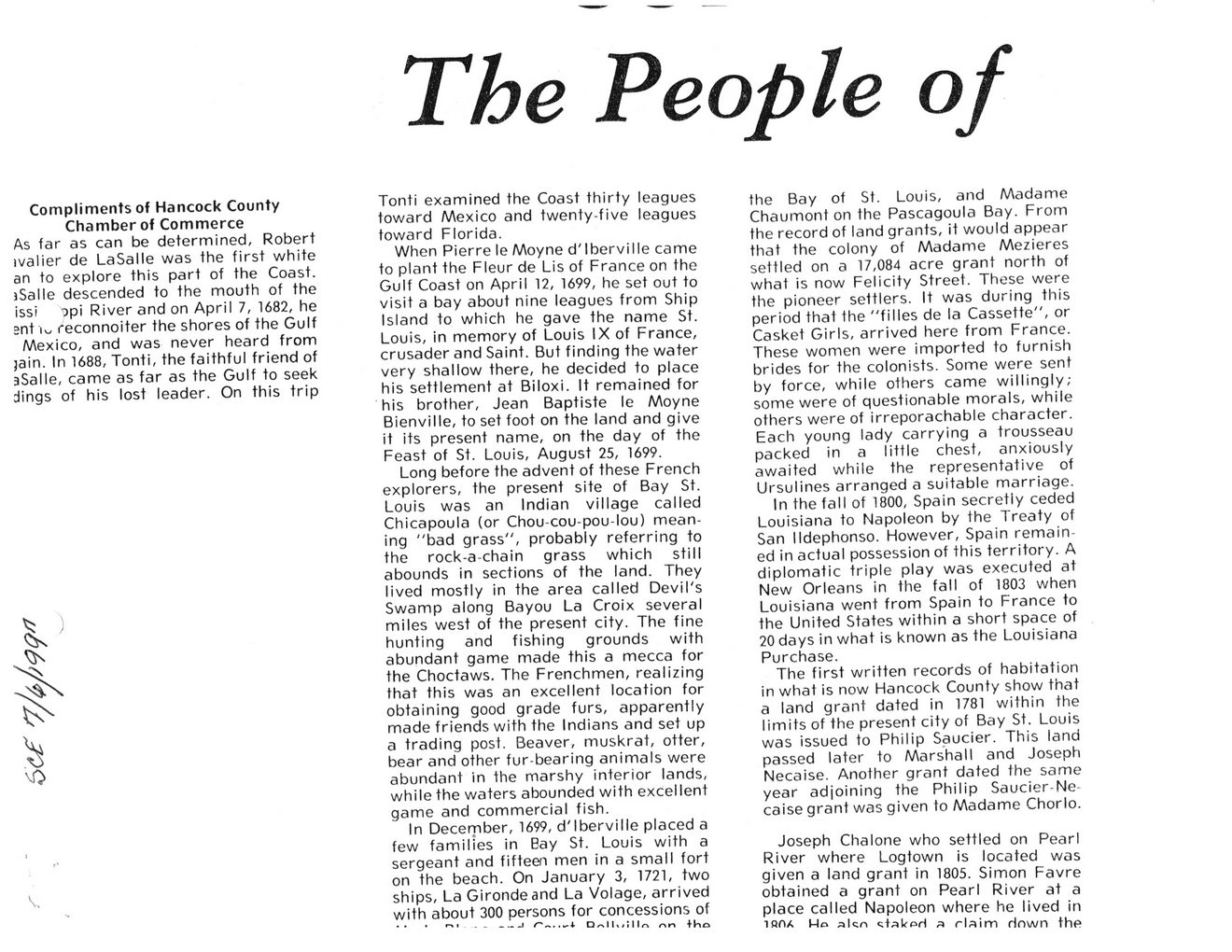This text was obtained via automated optical character recognition.
It has not been edited and may therefore contain several errors.
The People of Compliments of Hancock County Chamber of Commerce As far as can be determined, Robert ivalier de LaSalle was the first white an to explore this part of the Coast. jSalle descended to the mouth of the issi ?pi River and on April 7, 1682, he =nt iv, reconnoiter the shores of the Gulf Mexico, and was never heard from jain. In 1688, Tonti, the faithful friend of aSalle, came as far as the Gulf to seek dings of his lost leader. On this trip * \0 v. Tonti examined the Coast thirty leagues toward Mexico and twenty-five leagues toward Florida. When Pierre le Moyne d'lberville came to plant the Fleur de Lis of France on the Gulf Coast on April 12, 1699, he set out to visit a bay about nine leagues from Ship Island to which he gave the name St. Louis, in memory of Louis IX of France, crusader and Saint. But finding the water very shallow there, he decided to place his settlement at Biloxi. It remained for his brother, Jean Baptiste le Moyne Bienville, to set foot on the land and give it its present name, on the day of the Feast of St. Louis, August 25, 1699. Long before the advent of these French explorers, the present site of Bay St. Louis was an Indian village called Chicapoula (or Chou-cou-pou-lou) meaning "bad grass", probably referring to the rock-a-chain grass which still abounds in sections of the land. They lived mostly in the area called Devil's Swamp along Bayou La Croix several miles west of the present city. The fine hunting and fishing grounds with abundant game made this a mecca for the Choctaws. The Frenchmen, realizing that this was an excellent location for obtaining good grade furs, apparently made friends with the Indians and set up a trading post. Beaver, muskrat, otter, bear and other fur-bearing animals were abundant in the marshy interior lands, while the waters abounded with excellent game and commercial fish. In December, 1699, d'lberville placed a few families in Bay St. Louis with a sergeant and fifteen men in a small fort on the beach. On January 3, 1721, two ships, La Gironde and La Volage, arrived with about 300 persons for concessions of °1 -- —---1 Dr>ll»/!||A nn the the Bay of St. Louis, and Madame Chaumont on the Pascagoula Bay. From the record of land grants, it would appear that the colony of Madame Mezieres settled on a 17,084 acre grant north of what is now Felicity Street. These were the pioneer settlers. It was during this period that the "filles de la Cassette", or Casket Girls, arrived here from France. These women were imported to furnish brides for the colonists. Some were sent by force, while others came willingly; some were of questionable morals, while others were of irreporachable character. Each young lady carrying a trousseau packed in a little chest, anxiously awaited while the representative of Ursulines arranged a suitable marriage. In the fall of 1800, Spain secretly ceded Louisiana to Napoleon by the Treaty of San lldephonso. However, Spain remained in actual possession of this territory. A diplomatic triple play was executed at New Orleans in the fall of 1803 when Louisiana went from Spain to France to the United States within a short space of 20 days in what is known as the Louisiana Purchase. The first written records of habitation in what is now Hancock County show that a land grant dated in 1781 within the limits of the present city of Bay St. Louis was issued to Philip Saucier. This land passed later to Marshall and Joseph Necaise. Another grant dated the same year adjoining the Philip Saucier-Ne caise grant was given to Madame Chorlo. Joseph Chalone who settled on Pearl River where Logtown is located was given a land grant in 1805. Simon Favre obtained a grant on Pearl River at a place called Napoleon where he lived in non* Mo alcn a rl^im Hnwn the

Hancock County People-of-Hancock-County-article-(1)